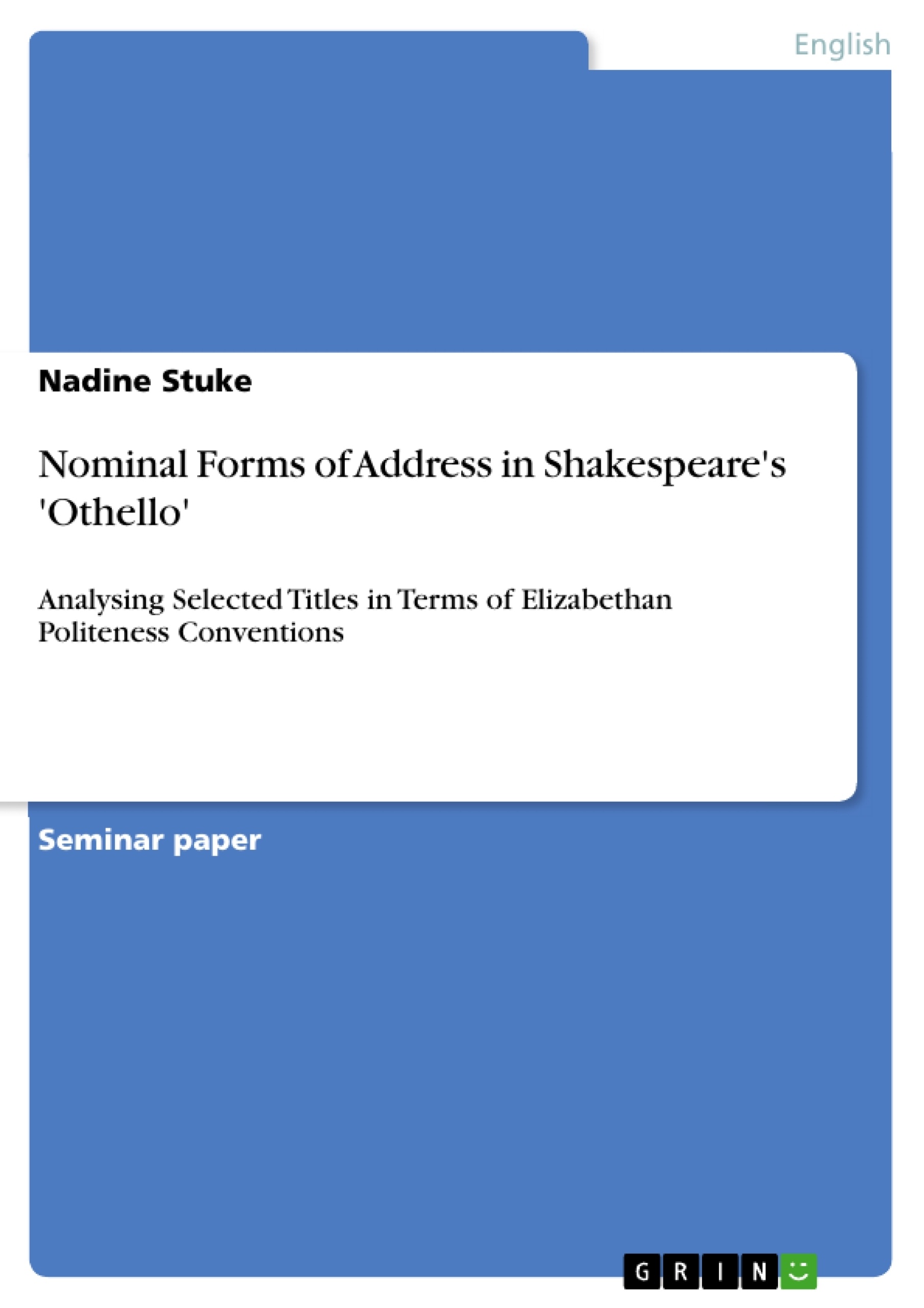Excerpt
Contents
1. Introduction
2. Brown and Levinson’s Concept of Politeness
3. Forms of Address in Early Modern English
3.1 Husband and Wife
3.2 Close Friends
4. Vocative Forms of Address in Shakespeare’s Othello
4.1 Husband and Wife: Othello and Desdemona
4.2 Friends: Othello and Iago
5. Conclusion
6. Works Cited
1. Introduction
Today, the concept of politeness is not associated with class consciousness or social discrimination anymore, but in the sixteenth century this term was commonly linked to deference and showing respect (Watts 34). Thus appropriate language behaviour was of utmost importance to Elizabethan society. People of that time were always anxious to please their interlocutors, especially with reference to forms of address.
Those address formulae had to be chosen accurately as they were very meaningful: Not only did they give information concerning personal relationships (Bruti 44) and emotions towards each other, but also about social ranks and hence power relations between speaker (S) and hearer (H). In Early Modern English times forms of address reflected the social hierarchy (Nevalainen & Raumolin-Brunberg 547; Replogle 102). So every title was assigned to a certain social status. To avoid using titles in an inappropriate or even impolite way, a lot of courtesy and conduct manuals were published (Watts 36).
In the following attention will be drawn on Shakespeare’s tragedy Othello (OTH) and the author’s use of address terms, particularly relating to salutations used by husband and wife and that between friends. Is Shakespeare’s choice of nominal address forms in accordance with Elizabethan conventions? By concentrating on the marital relationship between the characters Othello and Desdemona as well as on that between the two “friends” Othello and Iago, this term paper aims at answering this question. But before comparing Elizabethan conventions to Shakespeare’s dramatis personae, it is necessary to illuminate Brown and Levinson’s politeness concept that provides a basis for dealing with terms of address.
2. Brown and Levinson’s Concept of Politeness
The employment of forms of address can be regarded to be either polite or impolite (Jucker & Taavitsainen 10). Consequently terms of address and politeness are closely connected with each other. In this chapter focus will be on Brown and Levinson’s politeness model which was first published in 1978. Referred to as “the most influential pragmatic theory of politeness” (Blum-Kulka 50) their concept is still up-to-date and often applied by other critical researchers such as Brown and Gilman, Kopytko or psychological researchers like Holtgraves.
Brown and Levinson base their so-called “face-saving theory” (Watts 85) on “rationality” and “face” (Brown & Levinson 58). The latter is an idea originated from Goffman (1967). It is divided into positive face which means the appreciation by others and negative face as the personal freedom of action (Nevalainen & Raumolin-Brunberg 544). The notion of face is very important as it is “something that is emotionally invested, and that can be lost, maintained, or enhanced […]” (Brown & Levinson 61). Thus politeness strategies are created to maintain face which also means minimising or even avoiding the risks of a face-threatening act (FTA).[1]
There are five possible strategies for dealing with FTAs: don’t doing the FTA at all, off record, baldly on record and positive and negative politeness which are both on record strategies with regressive action (Brown & Levinson 69). Regarding our topic positive and negative politeness will be most important.
While positive politeness is a strategy of intimacy that meets the addressee’s positive face wants and shows solidarity, negative politeness strategies are concerned with saving H’s negative face and address his wish for non-interference (Brown & Levinson 70). It can be described as a deference politeness that increases distance. Positive politeness is employed concerning “lesser face threats” (Magnusson 21) whereas negative politeness strategies are used when the face threat bears a higher risk of face loss.
[...]
[1] Due to Brown and Levinson FTAs are “acts that by their nature run contrary to the face wants of the addressee and/or of the speaker” (65).
- Quote paper
- Nadine Stuke (Author), 2011, Nominal Forms of Address in Shakespeare's 'Othello', Munich, GRIN Verlag, https://www.grin.com/document/200303
Publish now - it's free






















Comments